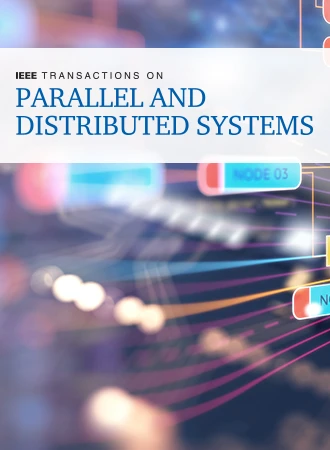$\text {GPUSCAN}^{++}$:高效的gpu结构图聚类
IF 6
2区 计算机科学
Q1 COMPUTER SCIENCE, THEORY & METHODS
IEEE Transactions on Parallel and Distributed Systems
Pub Date : 2025-06-24
DOI:10.1109/TPDS.2025.3582996
引用次数: 0
摘要
结构聚类是目前最流行的图聚类方法之一,利用gpu实现了很大的性能提升。尽管如此,最先进的基于gpu的结构聚类算法$\mathsf {GPUSCAN}$仍然存在效率问题,因为并行化引入了许多额外的成本。此外,$\mathsf {GPUSCAN}$假定图形驻留在GPU内存中。然而,目前GPU内存容量有限,而许多现实世界的图形很大,无法容纳GPU内存,这使得$\mathsf {GPUSCAN}$无法处理大型图形。基于此,本文提出了一种新的基于gpu的结构聚类算法${\mathsf {GPUSCAN^{++}}}$。为了解决效率问题,我们提出了一种新的针对gpu的渐进式聚类方法,既避免了高昂的并行化成本,又充分利用了gpu的计算资源。为了解决GPU内存限制问题,我们提出了一种基于分区的结构聚类算法,该算法可以在有限的GPU内存下处理大型图形。我们在真实图形上进行了实验,实验结果表明,当图形可以驻留在GPU内存中时,我们的算法与最先进的基于GPU的算法相比,可以实现高达168倍的加速。此外,我们的算法是可伸缩的,可以处理大型图形。作为一个例子,我们的算法可以使用不到2gb的GPU内存在一个有18亿个边的图上完成结构聚类。本文章由计算机程序翻译,如有差异,请以英文原文为准。
$\text {GPUSCAN}^{++}$: Efficient Structural Graph Clustering on GPUs
Structural clustering is one of the most popular graph clustering methods, which has achieved great performance improvement by utilizing GPUs. Even though, the state-of-the-art GPU-based structural clustering algorithm, $\mathsf {GPUSCAN}$ $\mathsf {GPUSCAN}$ $\mathsf {GPUSCAN}$ ${\mathsf {GPUSCAN^{++}}}$
求助全文
通过发布文献求助,成功后即可免费获取论文全文。
去求助
来源期刊

IEEE Transactions on Parallel and Distributed Systems
工程技术-工程:电子与电气
CiteScore
11.00
自引率
9.40%
发文量
281
审稿时长
5.6 months
期刊介绍:
IEEE Transactions on Parallel and Distributed Systems (TPDS) is published monthly. It publishes a range of papers, comments on previously published papers, and survey articles that deal with the parallel and distributed systems research areas of current importance to our readers. Particular areas of interest include, but are not limited to:
a) Parallel and distributed algorithms, focusing on topics such as: models of computation; numerical, combinatorial, and data-intensive parallel algorithms, scalability of algorithms and data structures for parallel and distributed systems, communication and synchronization protocols, network algorithms, scheduling, and load balancing.
b) Applications of parallel and distributed computing, including computational and data-enabled science and engineering, big data applications, parallel crowd sourcing, large-scale social network analysis, management of big data, cloud and grid computing, scientific and biomedical applications, mobile computing, and cyber-physical systems.
c) Parallel and distributed architectures, including architectures for instruction-level and thread-level parallelism; design, analysis, implementation, fault resilience and performance measurements of multiple-processor systems; multicore processors, heterogeneous many-core systems; petascale and exascale systems designs; novel big data architectures; special purpose architectures, including graphics processors, signal processors, network processors, media accelerators, and other special purpose processors and accelerators; impact of technology on architecture; network and interconnect architectures; parallel I/O and storage systems; architecture of the memory hierarchy; power-efficient and green computing architectures; dependable architectures; and performance modeling and evaluation.
d) Parallel and distributed software, including parallel and multicore programming languages and compilers, runtime systems, operating systems, Internet computing and web services, resource management including green computing, middleware for grids, clouds, and data centers, libraries, performance modeling and evaluation, parallel programming paradigms, and programming environments and tools.
 求助内容:
求助内容: 应助结果提醒方式:
应助结果提醒方式:


